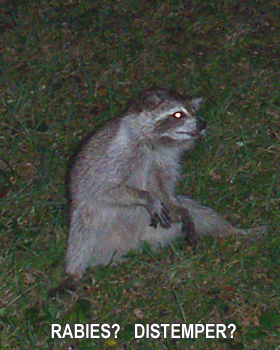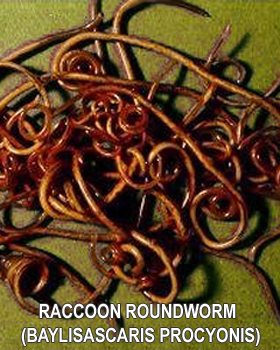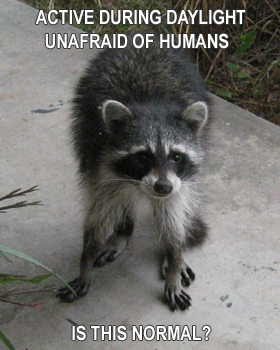Rabies -
Raccoons are the one of the most common reservoirs, or vectors, to carry rabies. Only a small percentage will have rabies, often segregated by geography. If ill with the disease, in the contagous state they will display symptoms. Anytime you see odd behavior in an animal,
it is a good idea to back away from it. Some of the behavior a rabid raccoon has is confusion, aggressiveness, making strange sounds, moving in an erratic manner in which they often drag a foot and a general ill appearance. A raccoon active during
daytime is not a giveaway. Hydrophobia (fear of water) is universal with animals infected
with the rabies virus because it is excruciatingly painful for them to swallow. Rabies is caused by the rhabdovirus which, when seen under the microscope has the shape of a bullet. Transmission of this virus usually occurs through a bite of an infected animal.
Symptoms Displayed By Rabid Raccoons:
- Disoriented or erratic movements
- Daytime presence
- Seizures
- Paralysis
- Collapsing
- Excessive salivation
- Aggression
- Hydrophobia
- Eating strange non-food things
Pets And Rabies -
Outdoor pets in the country are more prone to being bitten than indoor pets. Dogs in particular are very territorial and may get into a physical fight with a rabid raccoon. The only way to be sure an animal died of rabies is by examining the brain tissue after death. When negri bodies are present in brain tissue of a diseased animal, then a rabies infection can be confirmed.
Raccoon Roundworm -
The Latin name for these worms is Baylisascaris procyonis. It is a roundworm that is particular to raccoons. It is a roundworm that is particular to raccoons. The parasitic nature of B. procyonis is that it lives in the raccoons' intestinal tract. A raccoon can carry on the average a parasitic load of about fifty adult worms in its intestines. With every fecal movement the raccoon has, he also deposits many of the roundworm eggs onto the ground.
Pets And Raccoon Roundworms -
Pets can easily acquire an infection from raccoons by sniffing and ingesting the eggs found in the racoon feces. Once these eggs are ingested, they begin a new life cycle within the dog's intestines. From there, the worm larvae can travel to the central nervous system where they cause the infected pet to become seriously ill.
Giardiasis -
Many animals are the carriers of Giardiasis. This disease is neither a viral nor a bacterial infection. Giardia is a protozoon. It is carried in the feces of raccoons as well as many other animals. Pets can become ill with Giardia by drinking water that is contaminated with cysts from these intestinal protozoa. In general, the symptoms of infection are diarrhea and stool that smells foul. In addition, your pet may become anorexic and experience cramps in its abdomen. Analysis of the pet's feces may show the cysts in a fecal sample.
Leptospirosis -
This is a bacterial infection contracted through spirochetes. It is often transmitted through the urine of infected animals. Humans, who may have a small cut on their skin and pick up a leaf or some other part of nature after an infected raccoon has urinated on it, can themselves become infected. Walking your pets in an area where raccoons will roam could easily expose your pets to the bacteria. Dogs are known to not only sniff out strange odors but also to lick things they shouldn't. They will also drink water contaminated by Leptospira. Certain geographical areas have one or two dominant strains of the four strains of Leptospirosis. In some areas, especially in tropical environments like Florida, all four strains can be found.
Disease Prevention -
The best way to combat any disease is not to get it in the first place. Sometimes it is difficult to protect your pet from some illnesses because they are by nature curious and protective. Vaccination against some diseases are the best way to keep your pets healthy since you have no real control over raccoons invading your property, especially if you live in the country. You can also make your property uninviting to raccoons by removing all open trash containers or fitting them with a very tight lid. You may have to go so far as to lock the lids onto the can itself. Remove all pet food from patios or porches. Clearing brush and leafy debris from around your home removes hiding and nesting places. Do not give raccoons the chance to move into your garage, shed or attic by having open portals to those places.
Wild animals do not live by human codes of getting acquainted. To approach a wild animal can be dangerous in two ways. The animal can become aggressive and bite. The other danger is in spreading diseases to you or your pet. Some of the diseases that reside within wild animals can be fatal. Some may not necessarily afflict one particular animal type in a negative way but play havoc with human health or the health of pets.



